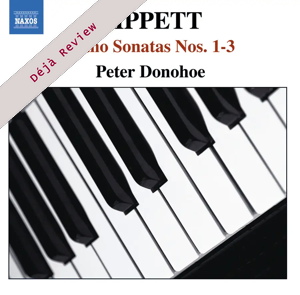
Déjà Review: this review was first published in November 2005 and the recording is still available.
Michael Tippett (1905-1998)
Piano Sonata No.1 (1936-1937, rev. 1942)
Piano Sonata No.2 (1962)
Piano Sonata No.3 (1973)
Peter Donohoe (piano)
rec. 2004, Potton Hall, Suffolk, UK
Naxos 8.557611 [54]
The catalogue is not exactly awash with recordings of this repertoire, which is a shame. At its best and worst, this music is as good as anything by Prokofiev, and how many versions of some of his sonatas do you have on your shelves?
Peter Donohoe’s new recording is very much to be welcomed, as it effectively replaces Nicholas Unwin’s currently unavailable Chandos issue of the same Sonatas. Pity the poor fourth sonata, which, it is to be hoped, will appear at some future date on Naxos. Tippett fanciers who are desperate for this late masterpiece will find Paul Crossley’s CRD recording more than adequate for now – if a little pricey by comparison. It is with his complete set that I will be comparing the new Naxos disc.
Donohoe’s piano sound is a little warmer and closer than Crossley’s, which is recorded in a more resonant acoustic. Of course, such head-to-head comparisons are always a little unfair. In short, both recordings are excellent, and the ear soon becomes accustomed to appreciating each balance as entirely natural. If however you prefer punchy bass sound in your piano recordings and a more ‘under the lid’ feeling, then Donohoe is your man. With Crossley, you are in the best seat in the concert hall; with Donohoe, you are the page turner.
Take the magnificent Allegro first movement of the first sonata. Donohoe comes in a whole minute shorter than Crossley. His superb touch and technique present a dazzling variety of dynamic contrast, lyrical expressiveness juxtaposed with all of the symphonic bravura of a young composer flexing his considerable creative muscles at the keyboard. Donohoe plays this music with less rubato than Crossley. While losing none of the rhythmic flexibility this music demands, he has a more attention-grabbing approach. He marries the more disparate elements of this movement by uncompromisingly letting them rub shoulders with each other, rather than allowing polite breathing space between them. His accuracy is also superior, notably in the massive octave passages just before the final recapitulation.
I was also interested to compare the second movement of the first sonata: with Donohoe coming in at 3:46 and Crossley at 5:15 there has to be some serious difference in opinion here. Bearing in mind that Crossley’s recording was made in the presence of the composer and therefore presumably with his approval, it might be tempting to regard it as being in some way definitive. Like all great music, however, there can be validity to several interpretations. Donohoe is again more concise and less self-consciously romantic in his approach, reflecting the innocence of Tippett’s use of ‘Ca’ the cowes tae the knowes’ as a thematic base for this movement. Crossley’s richer pedalling and rubato impose an extra level of Rachmaninovian pianism on the music which, as Donohoe proves, doesn’t necessarily heighten its emotional impact.
Moving on to the second sonata, Tippett’s mature voice is present right from the start, and again Donohoe’s exhilarating pianism and musicianship grab and hold one’s attention throughout the whole of this tightly argued single-movement work. One senses Donohoe’s educational experiences with Messiaen and Yvonne Loriod shining through here. His dancing, birdsong-like negotiation of the single-line figuration makes Crossley’s seem a little leaden and mannered by comparison. For Donohoe, the fleeting contrasts and micro-detail in this remarkable piece all have a connected purpose. With Crossley, they appear almost as a procession of disparate elements presented end-to-end.
At the opening of the third sonata, one’s jaw drops once more at Donohoe’s effortless magicianship with this ‘difficult’ music. His performance is one of power without commotion, atmosphere without static impressionism; at once exacting and detailed while at the same time expressive and engaging. I have been completely re-educated as to the substance and content of these pieces with this new recording. What more can one ask for a little more than a fiver!
Dominy Clements
Buying this recording via a link below generates revenue for MWI and helps us keep free access to the site




















